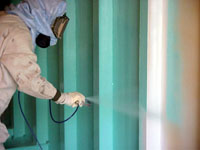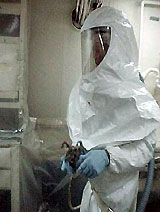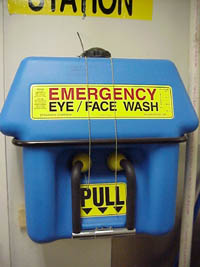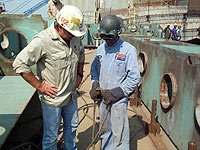Shipyard Employment eTool
Surface Preparation >> Flammable and Combustible Liquids
Fire and explosion hazards, Respiratory hazards, Contact with flammable and combustible liquids, Electrical hazards
Flammable and combustible liquids, including paint, solvents, and preservative removers, are used in all aspects of shipbuilding. The use, storage, and containment of these materials pose hazards to employees.
This section primarily focuses on the storage and containment of flammable and combustible liquids. For more detailed information regarding these materials, see the following:
- Painting and Other Coating Operations
- Cleaning and Other Cold Work
- Surface Preparation
- Hot Work (including Welding, Cutting, and Heating). Note: The information regarding Hot Work Operations and Maintaining Safe Conditions should be reviewed before proceeding with this section.
The storage and containment of flammable and combustible liquids can expose workers to the following hazards:
Note: Confined space entry is one of the leading hazards associated with barge cleaning. Review the Shipbuilding: Confined or Enclosed Spaces and Other Dangerous Atmospheres chapter for information on how to protect workers from this hazard.

Potential Hazards
Fire and explosions may be caused by:

- Spills of flammable and combustible liquids.
- Uncontrolled ignition sources in storage, mixing and transfer areas.
- Inadequate ventilation in storage, mixing and transfer areas.
- Painting. See Painting and Other Coating Operations [29 CFR 1915.35].

Requirements and Example Solutions
- Hot work must not be performed in the space and/or adjacent spaces when flammable or combustible liquids are being stored, mixed or transferred. [29 CFR 1915.36(a)(1) and 29 CFR 1915 Subpart P]
- Rags soaked with solvents must be placed in covered metal containers. [29 CFR 1915.36(a)(3) and 29 CFR 1915.81(a)(5)]
- Paints, thinners, and solvents must be kept in fire-resistant covered containers when not in use. [29 CFR 1915.81(a)(5)]
- Smoking and open flames must be prohibited in the area. [29 CFR 1915.36(a)(1)]
- Arcing and sparking equipment and tools must not be used. [29 CFR 1915.36(a)(1)]
- Equipment that may generate static electricity (e.g. ventilation systems) shall be grounded/bonded. [29 CFR 1915.13(b)(11)]
- Explosion-proof lights must be used. [29 CFR 1915.36(a)(4) and 29 CFR 1915.13(b)(9)]
- Adequate ventilation must be maintained in storage, mixing and transfer areas. [29 CFR 1915.13(b)(3) and 29 CFR 1915.36(a)(2)]
- Frequent tests must be required during mixing and spill clean-up to determine if air concentrations are below 10% of the LEL. [29 CFR 1915.15(f) and 29 CFR 1915.36(a)(2)]
-
The Shipyard competent person (SCP) must test the exhaust location to ensure that exhausted vapors do not accumulate to hazardous levels. [29 CFR 1915.13(b)(7), (b)(8), (b)(11), and (b)(12)]

- Suitable fire fighting equipment must be immediately available. [29 CFR 1915.36(a)(6)]
- Spills of solvents must be cleaned up immediately. [29 CFR 1915.13(b)(5)]
- 30 gallon drums and containers of flammable or toxic liquids must be placed in an area where they will not be subject to physical damage. [29 CFR 1915.173(d)]
- 30 gallon drums and containers of flammable or toxic liquids must be placed in an area where they will not be subject to physical damage. [29 CFR 1915.173(d)]
- 55 gallon drums containing flammable or toxic liquids shall be surrounded by dikes or pans. [29 CFR 1915.173(e)]
- Power and lighting cables must be inspected by a person competent to evaluate electrical hazards (not the Shipyard Competent Person) and ensure there are no connections within 50 feet of the storage, mixing, and transfer of flammable and combustible liquids. [29 CFR 1915.36(a)(5)]

Potential Hazard
Toxic vapors and mists produced by flammable and combustible liquids may present significant health hazards when transferred, mixed, or stored. These materials produce vapors that are often heavier than air, and can become highly-concentrate in confined and enclosed spaces, causing displacement of oxygen and increasing health risks.

Requirements and Example Solutions
- A hazard assessment must be made to determine the proper selection of respirators. [29 CFR 1915.152(b)]
- Many epoxy, anti-fouling, and coal tar pitch paints may cause respiratory damage, skin sensitization and possible life-threatening allergic reactions. Use of these materials required special precautions:
- Air-line respirators
- Gloves
- Many epoxy, anti-fouling, and coal tar pitch paints may cause respiratory damage, skin sensitization and possible life-threatening allergic reactions. Use of these materials required special precautions:
- Respirators must be used in accordance with 29 CFR 1915.154. [29 CFR 1910.134]

Additional Resources
- Ventilation. See Confined or Enclosed Spaces and Other Dangerous Atmospheres
- Respiratory Protection. OSHA eTool.
- Inspection procedures for the Respiratory Protection Standard. OSHA Directive CPL 02-00-158, (June 26, 2014).

Potential Hazards
Employees working with flammable and combustible liquids are at risk of harm if skin or eye contact occurs.
- Organ damage through skin or eye absorption.
- Skin or eye burns and irritation.
- Ingestion of contaminated food.

Requirements and Example Solutions
- A hazard assessment must be made to determine the proper selection of PPE. [29 CFR 1915.152(b)]
- The face, eyes, head, hands and all other exposed body parts of employees handling highly volatile paints shall be protected. [29 CFR 1915.35(b)(9)] Also see PPE Selection: Painting.
- Spills or other releases of flammable, combustible, toxic, corrosive and irritant materials must be cleaned up as work progresses. [29 CFR 1915.13(b)(5)]
- When clothing becomes saturated with flammable and combustible liquids, clothing should be changed immediately.
- Washing facilities must be available in case employees are exposed to these materials. [29 CFR 1915.88(e)(3)]
- Workers must be trained in the hazards and precautions of the materials they work with in accordance with the Hazard Communication Standard. [29 CFR 1915.1200]

Additional Information
- Hazard Communication Guidelines for Compliance. OSHA Publication 3111, (2000).
- Hazard Communication. OSHA Safety and Health Topics Page.

- Fixed or portable eye wash stations/safety showers should meet ANSI Z358.1-1998: Emergency Eye Wash and Shower Equipment.

Potential Hazards
Employees mixing or transferring flammable and combustible liquids with electrical equipment are exposed to increased risk of getting shocked or electrocuted due to:
- Faulty electrical connection in power tools.
- Open lighting parts.
- Broken insulation on power cords.
Note: Arcing and spark producing tools are not to be used where flammable liquids are capable of creating a flammable atmosphere. [29 CFR 1915.36]

Requirements and Example Solutions
- Portable electrical tools must be grounded or double insulated. [29 CFR 1915.132(a)]
- Temporary lighting must be grounded. [29 CFR 1915.82(b)(8)]
- Power and lighting cables must be inspected by a person competent to evaluate electrical hazards. (Note: This is not the Shipyard Competent Person). [29 CFR 1915.36(a)(5)]

- All electrical tools or equipment should undergo a visual inspection prior to use.
- All portable electric hand tools and temporary lighting systems should utilize Ground Fault Circuit Interrupters (GFCI).
- Electrical tools and equipment should correspond with the requirements of the job.
- Electrical equipment and tools should be used with proper circuit protection for the voltage and amperage used.
- Only qualified electricians should attempt repair of electrical tools and equipment in use.
- A Ground Assurance Program should be in place for all electrical tools and equipment used including:
- Records of tools inspected and repaired.
- Records of electrical boxes inspected and repaired.
- Records of electrical extension cords inspected and repaired.
- Recall of records of the above.
- The requirements of the Ground Assurance Program should be performed on a regular basis.


